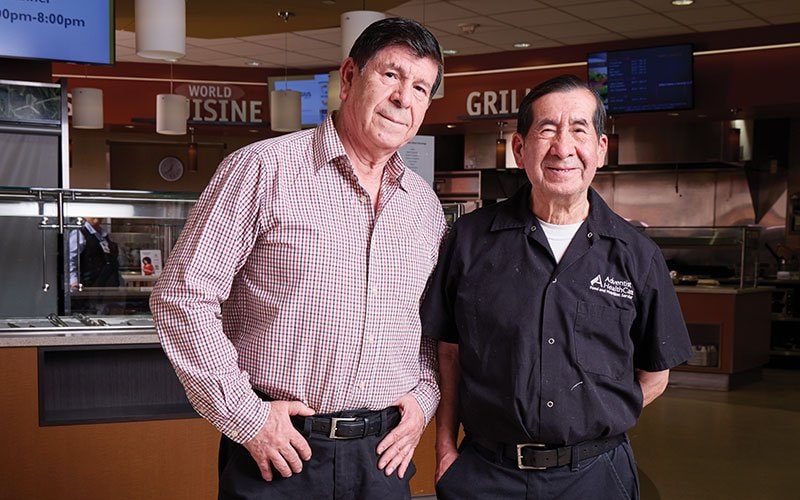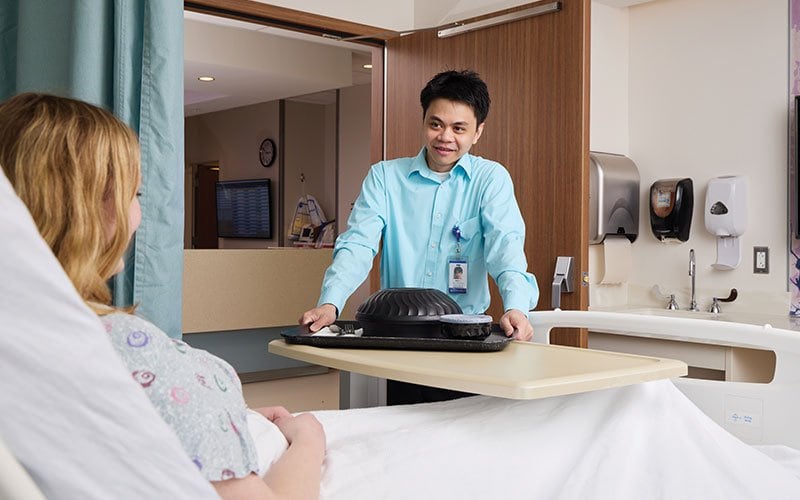
Cooking Up Good Health
In the kitchens across Adventist HealthCare’s hospitals, cooks and hosts work hard to make sure patients have the fuel they need to feel better and heal.
To encourage those who are navigating special diets or working hard to make healthier choices, here’s a peek at a few of the people behind our plates (and who challenge the notion that hospital food is bad!).
Brothers Devote Decades to Dishing Up Food at Shady Grove
For Jaime Revollo, the motivation for 39 years in the kitchen at Adventist HealthCare Shady Grove Medical Center in Rockville boils down to one thing: helping patients.

Jaime, a native of Bolivia, arrived at the hospital after years working in kitchens in Europe. A year after starting at Shady Grove, he was joined in the kitchen by his brother, Adrian.
Jaime’s day begins early, waking at 4 a.m. and cooking by 5. He prepares breakfast favorites, from biscuits to blueberry muffins and all kinds of eggs, for as many as 250 patients, plus caregivers and visitors in the cafeteria. Once breakfast ends, he quickly transitions to cooking patient lunches and gets a head start on preparations for the next day before heading home.
Cooking for the hospital requires Jaime to follow carefully thought-out recipes from Executive Chef Nick Haller, who must consider as many as 20 special diets in his plans. When not in the hospital kitchen, Jaime enjoys his wife’s cooking, adding he would love to add her empanadas to Shady Grove’s menu.
Meanwhile, as stock clerk, Adrian ensures the units throughout the hospital have what they need for patients who might want a snack or require extra nourishment between the arrival of meals to their rooms.
The brothers have seen many changes throughout nearly four decades in Shady Grove’s kitchen. Namely, the cafeteria’s menus have broadened from all-vegetarian options inspired by the hospital’s Seventh-day Adventist roots. Today’s menus also consider nutrition’s evolution, community preferences and diets that accommodate allergies.
Jaime has heard that food at hospitals gets a bad rap. He reminds everyone that he must follow doctor’s orders when preparing food for patients. “For example, you send them broth without salt. And patients say, ‘Oh, no salt!’ I can’t put salt because maybe they have high blood pressure. Also, I cannot put sugar or too much fat.” He also admits it’s hard to be excited when all you can eat is purées. However, he invites the community to try the food in the cafeteria, where he has more flexibility.
The brothers are always ready to keep the hospital community fed, no matter the challenge. Jaime remembers snowstorms when they stayed at Shady Grove for two weeks to make sure everyone had meals.
“I try in the best way and always in my mind are patients,”Jaime said, “because patients need to eat.”
Fort Washington Knows Best for Great Plates
For Executive Chef Trevor Best, nutritional services manager at Adventist HealthCare Fort Washington Medical Center, creating flavorful food is a passion. Growing up on the island of Barbados, where his family  ran a restaurant, Trevor aspired to become a chef. He studied the culinary arts in Boston. Since then, he has created many wonderful meals with Sodexo, an international food services company that serves Adventist HealthCare. When not cooking for the hospital, his family or friends, Trevor enjoys travel, jet-skiing and sailing.
ran a restaurant, Trevor aspired to become a chef. He studied the culinary arts in Boston. Since then, he has created many wonderful meals with Sodexo, an international food services company that serves Adventist HealthCare. When not cooking for the hospital, his family or friends, Trevor enjoys travel, jet-skiing and sailing.
His secret for savory summer meals: Pick colorful combinations of fruits and vegetables. And grill, grill, grill. He has a steak marinade that’s so good, you’ll want to use it year-round.
“This is one of my favorite marinades! If you are looking for tender, juicy, delicious steaks every time, try this,” Trevor said. “Pair it with grilled asparagus and grilled sweet potatoes to make a lovely meal on your grill or skillet.”
Marinade for four steaks
Ingredients
-
1/3 cup Worcestershire sauce
-
1/3 cup soy sauce
-
1/2 cup extra virgin olive oil
-
1/4 cup light brown sugar
-
2 teaspoon ground black pepper
-
2 teaspoons garlic powder or fresh garlic
-
1/4 cup honey
-
Steaks (any cut)
Instructions
- In a small bowl, whisk all liquid and powdered ingredients.
- Add steaks to a resealable zip-top bag or large bowl and pour the marinade over the steaks. Squeeze as much air out of the bag as possible and seal it.
- Marinate steaks for at least two hours or overnight in the refrigerator.
- To make steaks in the skillet: Turn heat to high and preheat for a few minutes until the skillet is hot. Place steaks in the skillet. Cook each side for three minutes; reduce heat to medium-high. Cook steaks to the desired doneness, flipping as needed, about 10 minutes, depending on the thickness of the steaks. (Trevor prefers to cook his to an internal temperature of about 150 F, which is medium-well).
- Let steaks rest three minutes on a warm plate before serving.
To make steaks on the grill:
Preheat the grill to medium-high. Place steaks on the grill. Cook for 4–6 minutes per side or until the internal temperature reaches at least 145 F for medium or 150 F for medium-well. For those who love well-done, cook to 160 F.
Leading the Feeding at White Oak
Mark Ledesma became a food service worker at the former Adventist HealthCare Washington Adventist Hospital in 2004. At the time, he was a student. The hospital was a 15-minute walk from his home. He was thrilled to find a job nearby, with an employer that was supportive of his studies and flexible about his class schedule. Today, the hospital has moved and become Adventist HealthCare White Oak Medical Center, but Mark is still in the kitchen. He is now food service supervisor, leading a team of 30.
 Each day is different for Mark, but he starts them the same way: He checks in with his team so that they feel prepared, supported and ready to do their part to care for White Oak Medical Center patients.
Each day is different for Mark, but he starts them the same way: He checks in with his team so that they feel prepared, supported and ready to do their part to care for White Oak Medical Center patients.
At a hospital, each meal involves many parts: taking orders; prepping, cooking and delivering food; washing dishes; checking equipment; and much more. Food service workers are ready to jump in and help with any role. Mark often leads by example and works alongside his team, as well as dietary assistants and meal hosts, to get it all done. He and his colleagues take pride in being part of a patient’s experience.
“In our role we want to make sure patients are eating food that contributes to their healing,” Mark explained. “We want to cater to each patient’s dietary requests, but if that isn’t what is best for their health, we will work with them to find desirable options that do support their healing.”
During Mark’s career at Adventist HealthCare, he has appreciated frequent opportunities to grow and learn. He was part of the team that moved the hospital from Takoma Park to White Oak in 2019. A new hospital meant new equipment. As a supervisor, it was his job to ensure his team felt comfortable and ready to feed patients when the hospital opened.
“It was exciting and challenging,” he shared. “Not everyone gets to do something like that in their career and it was great to be a part of it.”
The ability to connect and meet new people is one of Mark’s favorite parts of his job. “That feeling you get when you make a difference in a patient’s day is so rewarding,” he said.